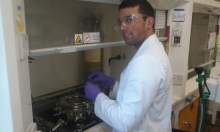
University:
Major:
Site Abroad:
Mentor(s):
Faculty Sponsor(s):
Faculty Sponsor's Department:
Project Title:
Project Description:
IDEs are increasingly being investigated for their use in electrochemical sensors especially in conductometric gas sensors (CGSs) as they exhibit high sensitivity due to their favorable geometry. For a CGS based on an IDE the most common substrates are glass, and in this work, flexible substrates are investigated for their potential use in the creation of more robust sensors.
Polypyrrole was chosen as the sensing layer due to its favourable interaction with our target gas molecule of ammonia. Polypyrrole was electrochemically deposited in between the gaps of interdigitated electrodes on flexible substrates. The deposited polymer was then oxidized in solution in order to enhance its conductive properties (doping). The response to ppb concentrations of ammonia was measured in a custom-made gas sensing chamber by monitoring the current at a constant applied potential.
At low concentrations, samples show a linear concentration-resistance response. In addition it was found that samples at higher resistances reacted proportionally more strongly towards ammonia than those at lower resistance values.
Scanning electron microscopy was performed to study the growth of the polymer which agreed with percolation theory. This theory informs us that the polymer network will me much more sensitive to disturbance near the percolation threshold, or the point at which conduction starts. At the percolation threshold, any small disturbance can move the sample to a disconnected state – increasing resistance dramatically.
It was encouraging that commercially available flexible substrates showed really good sensitivity towards ammonia vapor because they are cheap to produce and to operate, are durable, and resistant to damage.
